
Victor John Angelo Raschi was an American Major League Baseball pitcher. Nicknamed "the Springfield Rifle", he was one of the top pitchers for the New York Yankees in the late 1940s and early 1950s, forming the "Big Three" of the Yankees' pitching staff. He also pitched for the St. Louis Cardinals and the Kansas City Athletics.

Early Wynn Jr., nicknamed "Gus", was an American professional baseball right-handed pitcher. He played in Major League Baseball (MLB) for the Washington Senators, Cleveland Indians, and Chicago White Sox, during his 23-year MLB career. Wynn was identified as one of the most intimidating pitchers in the game, having combined his powerful fastball with a hard attitude toward batters. He was inducted into the Baseball Hall of Fame in 1972.
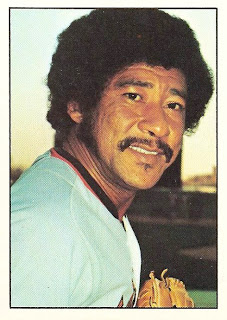
Miguel Ángel Cuellar Santana was a Cuban professional baseball player. He played for 15 seasons in Major League Baseball as a left-handed pitcher in 1959 and from 1964 through 1977, most prominently as a member of the Baltimore Orioles who won the American League (AL) pennant in each of Cuellar's first three seasons with the team. During that time, Cuellar and the Orioles won the 1970 World Series. Cuellar also played for the Cincinnati Reds, St. Louis Cardinals, Houston Astros and California Angels.

Don James Larsen was an American professional baseball pitcher. During a 15-year Major League Baseball (MLB) career, he pitched from 1953 to 1967 for seven different teams: the St. Louis Browns / Baltimore Orioles, New York Yankees (1955–1959), Kansas City Athletics (1960–1961), Chicago White Sox (1961), San Francisco Giants (1962–1964), Houston Colt .45's / Astros (1964–65), and Chicago Cubs (1967).
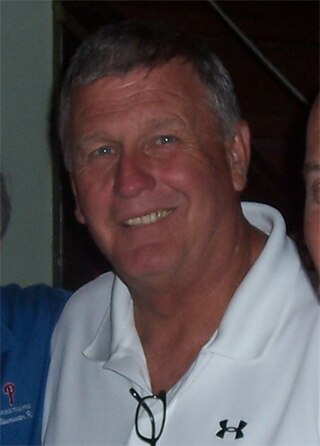
Thomas Edward John Jr., nicknamed "the Bionic Man," is an American former professional baseball pitcher who played in Major League Baseball (MLB) for 26 seasons between 1963 and 1989. He played for the Cleveland Indians, Chicago White Sox, Los Angeles Dodgers, New York Yankees, California Angels, and Oakland Athletics. He was a four-time MLB All-Star and has the second-most wins (288) of any pitcher since 1900 not in the Hall of Fame. Known for his longevity, John was the Opening Day starter six times – three for the White Sox and three times for the Yankees.

Frank Daryl Tanana is an American former professional baseball left-handed pitcher. In a Major League Baseball career that stretched from 1973 to 1993, he pitched for the California Angels, Boston Red Sox, Texas Rangers, Detroit Tigers, New York Mets, and New York Yankees. He struck out 2,773 batters in his career and twice won playoff-clinching games for the teams he was on, the 1979 Angels and the 1987 Tigers.

Charles Henry "Chinski" Root was an American Major League Baseball pitcher with the St. Louis Browns and the Chicago Cubs between 1923 and 1941. Root batted and threw right-handed. He holds the club record for games, innings pitched, and career wins with 201.

Allan Fulton Worthington, nicknamed "Red", is a former professional baseball pitcher. He played all or part of 14 seasons in Major League Baseball for the New York / San Francisco Giants, Boston Red Sox (1960), Chicago White Sox (1960), Cincinnati Reds (1963–64) and Minnesota Twins (1965–69). Worthington batted and threw right-handed.

David Arthur McNally was an American professional baseball player. He played in Major League Baseball as a left-handed pitcher from 1962 through 1975, most notably as a member of the Baltimore Orioles dynasty that won four American League pennants and two World Series championships between 1966 and 1971. A three-time All-Star, McNally won 20 or more games for four consecutive seasons from 1968 through 1971. He was one of four 20-game winners for the 1971 Orioles, currently the last team as of 2023 to have four 20-win pitchers on the same roster.

Wilbur Forrester Wood Jr. is an American former professional baseball pitcher. In a 17-year Major League Baseball (MLB) career, he pitched for the Boston Red Sox (1961–64), the Pittsburgh Pirates (1964–65), and the Chicago White Sox (1967–78). A knuckleball specialist after joining the White Sox, he threw left-handed and batted right-handed.

James Leslie "Hippo" Vaughn was an American left-handed pitcher in Major League Baseball. In a career that spanned thirteen seasons, he played for the New York Highlanders, the Washington Senators (1912), and the Chicago Cubs (1913–1921). Vaughn won over twenty games in five out of nine seasons for the Cubs, over seventeen games in seven of them. His highlight year was 1918, where he earned a National League-leading 22 wins when the season was ended a month early due to government restrictions brought about by World War I. That same year, Vaughn also led the National League in earned run average (ERA) and strikeouts to become the ninth triple crown winner in the modern era and the fifteenth overall. His nickname of "Hippo" came from his height of 6 feet 4 inches and weight of 215 pounds.

Myron Walter Drabowsky was an American professional baseball pitcher who played in Major League Baseball (MLB) for the Chicago Cubs, Milwaukee Braves, Cincinnati Reds, Kansas City Athletics, Baltimore Orioles, Kansas City Royals, St. Louis Cardinals, and Chicago White Sox. A noted practical joker, Drabowsky engaged in such antics as leaving snakes in teammates' lockers or phoning the opposing team's bullpen to tell a pitcher to warm up. He batted and threw right-handed.

Thomas Virgil Sturdivant, nicknamed "Snake", was an American pitcher who played for the New York Yankees, Kansas City Athletics, Boston Red Sox, Washington Senators, Pittsburgh Pirates, Detroit Tigers, and New York Mets of Major League Baseball. He threw a curveball and a knuckleball, among other pitches. He batted left-handed but threw right-handed.
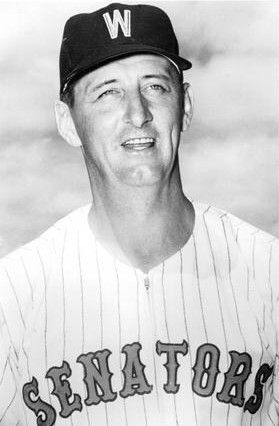
Richard Edward Donovan was an American Major League Baseball pitcher who played for the Boston Braves (1950–1952), Detroit Tigers (1954), Chicago White Sox (1955–1960), Washington Senators (1961) and Cleveland Indians (1962–1965). He batted left-handed and threw right-handed, stood 6 feet 3 inches (1.91 m) tall and weighed 190 pounds (86 kg).

James Anthony Shields is an American former professional baseball starting pitcher. He played in Major League Baseball (MLB) for the Tampa Bay Rays from 2006 through 2012, the Kansas City Royals in 2013 and 2014, the San Diego Padres in 2015 and 2016, and the Chicago White Sox from 2016 to 2018. He was an All Star in 2011.
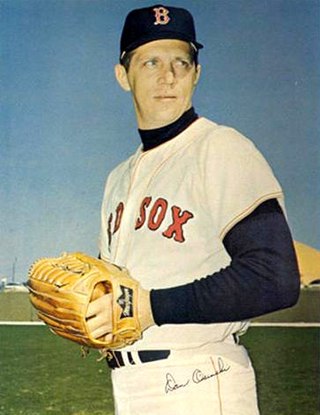
Daniel Osinski, nicknamed "The Silencer", was an American Major League Baseball relief pitcher. The 6 ft 2 in (1.88 m), 195 pounds (88 kg) right-hander was signed by the Cleveland Indians as an amateur free agent before the 1952 season. He played for the Kansas City Athletics (1962), Los Angeles Angels (1962–1964), Milwaukee Braves (1965), Boston Red Sox (1966–1967), Chicago White Sox (1969), and Houston Astros (1970).
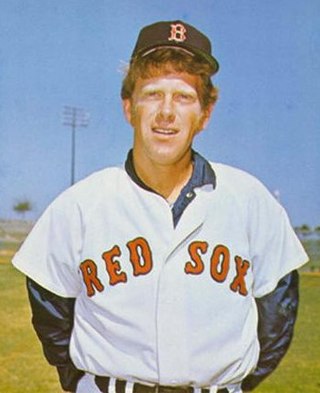
Lewis Bernard Krausse Jr. was an American professional baseball pitcher who played 12 seasons in Major League Baseball (MLB). He played for the Kansas City / Oakland Athletics, Milwaukee Brewers, Boston Red Sox, St. Louis Cardinals, and Atlanta Braves from 1961 to 1974. He batted and threw right-handed and served primarily as a starting pitcher. Once a highly-touted prospect, he had to overcome arm trouble early in his career and spent most of his career with teams that offered low run support.
The 1951 St. Louis Browns season involved the Browns finishing 8th in the American League with a record of 52 wins, and 102 losses.
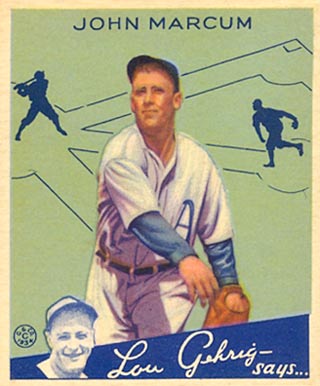
John Alfred Marcum, nicknamed "Footsie" and "Moose", was an American professional baseball pitcher. He played for seven seasons in Major League Baseball (MLB) with the Philadelphia Athletics, Boston Red Sox, St. Louis Browns, and Chicago White Sox. Over seven seasons, he had a 65–63 record and a 4.66 earned run average (ERA).

Sigmund Jakucki, nicknamed "Sig" or "Jack", was an American pitcher in Major League Baseball who appeared in 72 games over all or part of three seasons for the St. Louis Browns. He is best known for defeating the New York Yankees, 5–2, in the final game of the 1944 regular season to clinch the American League (AL) pennant for the Browns, their only AL championship. A hard-throwing right-hander, he was listed as 6 feet 2 inches (1.88 m) tall and 198 pounds (90 kg).






















